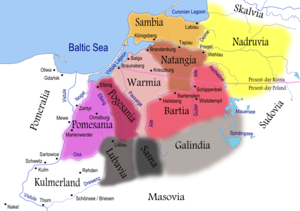Siege of Königsberg
| Siege of Königsberg | |||||||
|---|---|---|---|---|---|---|---|
| Part of the Great Prussian uprising | |||||||
 Prussian tribes in the 13th century | |||||||
| |||||||
| Belligerents | |||||||
|
Teutonic Knights | Prussians | ||||||
The siege of Königsberg was a
History
Background
Pagan Prussians rose against their conquerors, who tried to convert them to Christianity, after Lithuanians and Samogitians soundly defeated the joint forces of the Teutonic Knights and the Livonian Order in the Battle of Durbe in 1260. The first years of the uprising were successful for the Prussians, who defeated the Knights in open battles and besieged Teutonic castles. However, the Prussians faced great difficulties attacking and capturing the castles.
Battle of Kalgen
The Prussians had built small forts around Königsberg so that they could block any contact with the outside.
Control of the Pregel
A Sambian leader,
End of the siege
The conclusion of the siege is disputed. Königsberg historian
The Königsberg archivist Fritz Gause states that little is known of how the siege actually ended, that neither Armstedt nor historian Walther Franz provided a source for the final battle, and that the Teutonic chronicler Peter of Dusburg does not provide detail about it.[1] Gause states the Prussians abandoned the siege in 1265, possibly having heard that Königsberg was to receive crusading reinforcements.[1]
The Sambians withdrew because they could neither stop supplies and reinforcement from reaching the castle via the Pregel nor capture it. The siege proved the weakness of the Prussians and the strength of the Knights. The reliance upon fortified castles allowed the Knights to regroup and eventually subdue the uprising. Königsberg became a key staging ground for future crusading campaigns.[8]
Notes
References
- Armstedt, Richard (1899). Geschichte der königl. Haupt- und Residenzstadt Königsberg in Preussen (in German). Stuttgart: Hobbing & Büchle. p. 354.
- Ewald, Albert Ludwig (1884). Die Eroberung Preussens durch die Deutschen (in German). Halle a. S.: Verlag der Buchhandlung des Waisenhauses.
- Gause, Fritz (1965). Die Geschichte der Stadt Königsberg. Band I: Von der Gründung der Stadt bis zum letzten Kurfürsten (in German). Köln: Böhlau Verlag. p. 571.
- Urban, William (2000). The Prussian Crusade (2nd ed.). Chicago, Illinois: Lithuanian Research and Studies Center. pp. 284–287. ISBN 0-929700-28-7.
- Mémoires de l'Academie impériale des sciences de St. Pétersbourg - sixième série. Saint-Pétersbourg: L'académie impériale de sciences. 1859. (in French and German)
